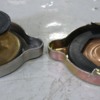quote:a sealed expansion tank cap.
I've read here others say the expansion cap is supposed to be vented (hole in the top), I'm not sure which is correct there, I know my car runs with everything sealed completely.
A radiator cap fitting is designed to be sealed in two places. At the top of the fitting 'neck', and at the smaller diameter passage inside the 'neck'.
When the fitting is in the pressure tank of a coolant system, both seals come into play. The wider top-of-the-neck seal keeps the system closed, allowing pressure to build and also allowing a vacuum to occur upon cool-down, which draws coolant from the expansion tank. More on that later.
The smaller diameter seal is designed to open at the rated pressure, preventing system damage. When that smaller seal is forced open by high pressure, the hot coolant and hot gases is directed into the expansion tank through the small hose in the neck of the pressure tank fitting, where it is retained until cool-down vacuum draws it back into the pressure tank.
AND... (this is the later part)
within the radiator cap itself is a third, small "vacuum" seal that comes into play during the cool-down of the system. That seal has a very weak spring that allows a vacuum-induced flow of coolant from the expansion tank back into the cooled-down pressure tank.
If a pressure cap is used on the expansion tank, the hot coolant and hot gases cannot escape until pressure rises to the rated pressure of the cap.
BUT, there is no reason to trap that pressure in that tank. That is why all the caps on all modern cars' expansion tanks do NOT have a pressure rating.
You can put a pressure-rated cap on the expansion tank, but it prevents the release of the hot gases and steam.
I'm happy that your car is running with an incorrect expansion tank cap.
But, I know what is correct. If the cap on your expansion tank is identified with a psi rating, it is not correct.
You are free to believe as you please.
Larry
good, short video on how a pressure cap works.
https://www.youtube.com/watch?v=0JdDWWoX-70
pressure rated cap on the left, non-pressure rated cap on right


